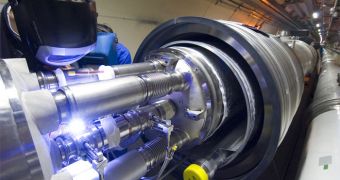Most of the universe we live in is made of matter, not anti-matter, but, while to create anti-matter particles is extremely easy here on Earth, they immediately decay through what we call anti-particle annihilation, when an elementary particle and its counterpart interact and decay into pure energy, or particles that also decay instantly to dissipate the energy of the collision. The strangest things of all, though, is the fact that anti-particles do not seem to obey exactly the laws the ordinary particles are subjected to, a violation of the Standard Model of particles physics commonly known as CP-symmetry violation.
This brings us again to the question 'why'. Why is the universe mostly made of ordinary matter? Could there be a parallel universe where anti-matter is dominant and life exists in? The first evidence of CP-symmetry violation was observed during an experiment at the Brookhaven Laboratory in 1964, which showed the small differences between matter and anti-matter that make the universe the way we experience it today.
The Standard Model had no theoretical model to support the matter-anti-matter asymmetry, mostly because models based only on two types of quarks, up-down and charmed-strange, do not allow it. Only by including the third pair of quarks, top-bottom, the theory may finally support CP-symmetry violation. Through an odd turn of events the existence of the top-bottom quark pair had been predicted before they were discovered and incorporated into the Standard Model.
But the six-quark theory only explains one type of matter-anti-matter asymmetry, thus the others had to be connected through observations of the decay of particles. Bottom mesons decay asymmetry can be correlated to strange meson decay, experiments that were carried out as soon as 1964, to explain the properties of quark particles which cannot exist in a free state in nature, but only bound with other quarks into known elementary particles.
Today we are able to conduct observations on the decay of particles by using computer models. One of such computer simulations was actually capable of revealing the oscillation between a K meson and its counterpart, of 5 billion times per second, an extremely small difference which would not exist at all if the down quarks were to have no mass. Physicists argue that there may by additional much larger oscillations which may obscure those determined by the down quark to disable the correct calculation of the oscillation mechanisms.
Alternatively, a computational model was constructed in the 1990s, model that gives fermion particles the ability to move in a four dimensional environment, with the space-time component that represents a fifth spatial dimension. As fermions move into the fifth dimension, they gain mass, which would explain why they haven't been observed yet into physical experiments. But when -1/2 spin particles move along only two dimensions, they appear physical to us.
Results of experiments conducted in the last decades into the study of QCD lattices reveal that the five-dimensional domain wall fermion method is the only one that can incorporate subtleties determined by the small masses of quarks and give reasonable accuracy to the experiments conducted today. Nonetheless, the question still remains, why not anti-matter? Physicists argue that one possibility is that in fact CP-symmetry violation may have nothing to do with the amount of matter and anti-matter in the universe, but could just be the outcome of the cooling process of the universe after the Big Bang which favored the creation of more matter than anti-matter.
Ultimately, the six-quark theory is able to explain all the observed event in the past experiments, however the asymmetry between quarks and anti-quarks still seems to be too low to explain the matter-anti-matter asymmetry observed in the universe.

 14 DAY TRIAL //
14 DAY TRIAL //